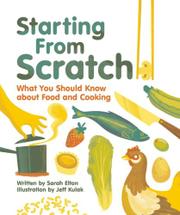7 Steps to Better Family Food Choices

Sarah Elton's practical book for kids
Published in baystateparent magazine
Most of us grew up with the USDA’s food pyramid: a visual manmade wonder to guide us toward making healthy food choices. We were taught we could obtain the pinnacle of health by eating just the right number of servings from various food groups, without more than a nod towards the shape-shifting nature of the pyramid’s groups over the years, or the source of our food itself.
Parenting brings with it a whole new dimension to how we view food: we try to make wise food choices not only for our own health but also for the health of our children. Is baby formula an adequate substitute for breast milk? Should moms choose Gerber sweet potatoes over home-pureed carrots? As our kids grow, the control we have over their food choices shrinks. Suddenly, we are scanning school cafeteria menus instead of recipes in Baby Love. Our kids are growing up, foraging for favorite foods of their own, likely influenced not by the appeal of the food itself as much as the pull of marketing, the convenience of a coin-operated machine, the draw of a fast sugary fix during a tough middle school day.
What ever happened to food as our grandparents knew it? And can we help our kids rediscover — or discover for the first time — the source, taste, satisfaction and necessity of real food?
These basic questions are growing in importance as our children grow up in an age where even the basic “healthy” grocery produce is genetically altered, pre-picked, re-packaged, and costs more than a bag of Doritos or a liter of Coke. With US childhood obesity rates more than tripling in the last 30 years, and 20% of all children ages 6 to 19 either overweight or obese, the answers to these questions have become imperative for parents of kids at any age.
Here are seven small steps you can take to help your kids learn more about the sources, variety, adventure and enjoyment of growing, buying, preparing and eating real food, whether they are a toddler or a teenager:
1. Take Stock of Yourself and Your Shelves
Kids — young children especially — love to imitate their parents. It’s no different with the food they see you eat. If you want your kids to make healthy food choices, you have to make good choices for yourself. Take stock of your pantry shelves and your personal food choices. Are you serving yogurt to your kids and hiding the Hagen Das for yourself? Are there low fat alternatives in your pantry like pretzels to high fat fare like chips? While there’s plenty of room to enjoy not-so-healthy food now and then, change toward stocking up and eating real food should be the norm, not the exception in your home.
2. Get Dirty with a Home Garden
You don’t need to dig deep to reap the benefits of planting food from seed with your child and watching it grow into delicious produce. Start small: grow peppers instead of potatoes; cherry instead of beefsteak tomatoes. Plant some blueberry bushes or a strawberry patch in your backyard. In the winter, place potted herbs like rosemary, sage or cilantro near your stove, and have your kids snip some fresh flavor to add to a dish. Kids take pride in the food they grow and are more likely to explore new foods from a plant they’ve nurtured and cared for.
3. Join a CSA or Frequent a Farmer’s Market
Community Supported Agriculture (CSA) farms are plentiful in Massachusetts, with over 160 listed on the mass.gov website. When you join a CSA, you pay for a weekly or bi-weekly share of fresh, locally grown food in season, which can include vegetables, flowers, fruit, and sometimes even meat. Most CSAs also encourage members to pitch in with planting, weeding, harvesting and other farm chores. Some even have children’s gardens and programs. Being part of a local CSA is a great way to support local farming while exposing your child first-hand to farming. Don’t have a CSA near you? Consider buying local produce through one of many farmer’s markets that are cropping up in Massachusetts. Farmer’s markets usually have fresh-baked goods, local cheeses, jams and other made-from-scratch goodies that taste delicious.
4. Create Kitchen Cooking Adventures
According to author and food journalist Sarah Elton, kids learn most about food by cooking and exploring with different tastes in their own kitchen. Her vision is for kids to discover that simple home cooking is fun, exciting and empowering. In her new book, Starting From Scratch, Eaton helps kids learn about food sources, cultural variety, the science behind cooking, and more. One way you can encourage cooking creativity is to choose some of your child’s favorite foods, then host a taste test by combining different ingredients together. Or, make some simple foods from scratch like pasta sauce or granola. Your kids will discover that foods made from scratch can taste way better than supermarket alternatives.
5. Look at Labels
Whether you take your child grocery shopping, buy a Kid’s Meal at McDonald’s, or simply pull some cans down from the pantry shelf, show your child how to read nutritional labels, and explain why it is important to know what’s in the food they eat. Children and (sometimes) adults will be surprised to learn how many processed foods have high amounts of sugar and salt added to them, from barbecue sauce to tomato soup. Helping kids identify sugars, salt and fat in their food on their own will make them more aware of the real nutritional value of what they’re eating.
6. Tune out TV Advertising
If your children routinely watch commercial television programming, watch out: Researchers at the Kaiser Family Foundation found that of all children’s food commercials aired, 40% advertise candy, snacks and fast food. Another 30% are cereal commercials. Ads for fresh fruit, vegetables and poultry are non-existent. Children under age eight see only one fitness or nutrition-related ad for every 26 food ads. Consider television viewing alternatives like public TV, streaming shows without advertising, or better yet, watch some cooking shows with your kids — you both may learn something new about food and food preparation.
7. Feed a Child or Family in Need
Even young children can understand that not every child has access to food — a basic necessity for life. Open your child’s eyes to see food as much more than something that tastes yummy or yucky. According to the humanitarian aid group World Vision, $50 can provide $300 of food — enough to feed seven families of six for one month. Organizations such as Feed the Children, Compassion International, and UNICEF provide food and other essentials to hungry children around the world. Consider how you can get your children involved: for example, host a make your-own pizza night rather then have pizza delivered, then use the savings to help save other children’s lives.
The food pyramid is helpful, but what’s really needed to change our children’s current and future relationship to food is a new food paradigm. These seven steps are small, but can make significant inroads toward creating a healthy generation of kids who care about the food they eat.
 My professional experience includes leading the creative efforts of three companies I have co-owned. I'm a seasoned copywriter/creative director, award-winning journalist, avid runner, and mom of four. Got a story idea you'd like to share? Email me at treske@nowspeed.com. You can also find me on Twitter: @trishreske, LinkedIn and Facebook.
My professional experience includes leading the creative efforts of three companies I have co-owned. I'm a seasoned copywriter/creative director, award-winning journalist, avid runner, and mom of four. Got a story idea you'd like to share? Email me at treske@nowspeed.com. You can also find me on Twitter: @trishreske, LinkedIn and Facebook.